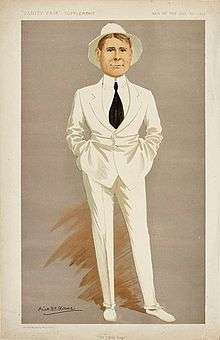Robert Loraine
Robert Bilcliffe Loraine DSO, MC (14 January 1876 – 23 December 1935) was a successful London and Broadway British stage actor, actor-manager, and soldier who later enjoyed a side career as a pioneer aviator. Born in New Brighton, his father was Henry Loraine and mother Edith Kingsley (born Mary Ellen Bayliss).[1] Robert made his first stage appearance in the English provinces in 1889, prior to serving in the Second Boer War. He introduced the George Bernard Shaw play Man and Superman to Broadway in 1905.[2][3]
Robert Loraine | |
|---|---|
 "The Flying Stage" Loraine as caricatured in Vanity Fair, 10 January 1912 | |
| Born | Robert Bilcliffe Loraine 14 January 1876 New Brighton, Liscard, Cheshire, England |
| Died | 23 December 1935 (aged 59) London, England |
| Occupation | actor soldier actor-manager aviator |
| Years active | 1889–1935 |
| Spouse(s) | Winifred Lydia Strangman ( m. 1901) |
| Awards | Distinguished Service Order Military Cross |
Theatrical career
Loraine was a versatile actor and was successful both in serious plays and in popular works of light entertainment. He was particularly associated with the works of George Bernard Shaw, taking over the role of John Tanner from Harley Granville Barker in the fourth[4] run of Man and Superman at the Royal Court Theatre. He also won critical acclaim for performances in plays by William Shakespeare and August Strindberg.
Aviation
In 1909 Loraine took up the new technology of aviation learning first to fly at the Bleriot school at Pau, France. He then switched to the easier to fly Farman biplane, on which he achieved great fame. In September 1910 he made what is credited as being the first aeroplane flight from England to Ireland, although he actually came down in the sea about 200 feet (60 metres) from the shore.[5] The same month he piloted one of the two Bristol Boxkites which took part in the British Army manoeuvres on Salisbury Plain, during which he sent the first radio signals to be sent from an aeroplane in Britain.[6] His diary is cited by the Oxford English Dictionary as the first written example of the word joystick to describe aircraft stick controls.
Military career
Loraine served as a volunteer in the Second Boer War between 1899 and 1901.[7] During the First World War he flew with the Royal Flying Corps (RFC). Formerly a lieutenant in the Special Reserve serving as a flying officer RFC, he was appointed to be a flight commander with the rank of captain on 15 September 1915.[8] He was awarded the Military Cross for his "conspicuous gallantry and skill" in shooting down an Albatross biplane on 26 October 1915.[9] On 24 April 1916 he was promoted to command a squadron, with the rank of major,[10] and on 13 February 1917 he was appointed a wing commander, with the rank of lieutenant colonel;[11] he was awarded the Distinguished Service Order the same year "for distinguished service in the field".[12] He was twice seriously wounded, and commanded No. 40 Squadron.[13] During his service he did not entirely abandon the theatre, running a drama society in his squadron, which performed the premiere performance of Shaw's play O'Flaherty V.C. at Treizeenes in Belgium.[14] On 11 December 1918 he relinquished his commission in the Royal Air Force due to ill-health brought on by his wounds, and was granted the honorary rank of major.[15]
Personal life
On 7 November 1897 Loraine married Julie Opp. After their divorce he married Winifred Lydia, daughter of Sir Robert Strangman in 1901. They had three daughters.
Biography
Loraine's life is the subject of Lanayre D. Liggera's well researched biography The Life of Robert Loraine:The Stage, the Sky, and George Bernard Shaw c.2013.[16]
Selected filmography
- Bentley's Conscience (1922)
- S.O.S. (1928)
- Birds of Prey (1930)
- Outcast Lady (1934)
- Marie Galante (1934)
References
- Oxford Dictionary of National Biography
- Robert Loraine at IBDb.com
- The Oxford Companion to American Theatre 2nd edition by Gerald Bordman, c. 1992; by The Oxford University Press
- Desmond MacCarthy, The Court Theatre, 1904–1907 (1966 edition), pp. 122, 127, 142, 152
- Mr Loraine's Irish Channel Flight Flight International 17 September 1910
- Barnes, C. H.,Bristol Aircraft Since 1910. London, Putnam, 1988, p.15.
- "Loraine, Robert Bilcliffe (1876–1935)". Oxford Dictionary of National Biography (online ed.). Oxford University Press. doi:10.1093/ref:odnb/67813. (Subscription or UK public library membership required.)
- "No. 29316". The London Gazette. 5 October 1915. pp. 9760–9761.
- "No. 29371". The London Gazette (Supplement). 18 November 1915. p. 11450.
- "No. 29573". The London Gazette. 9 May 1916. p. 4553.
- "No. 29965". The London Gazette (Supplement). 1 March 1917. p. 2098.
- "No. 30111". The London Gazette (Supplement). 4 June 1917. p. 5471.
- The Late Robert Loraine Flight 2 January 1936, p. 13
- Gill, Peter. "The Stage History of Shaw's O'Flaherty VC". Archived from the original on 27 December 2010. Retrieved 12 February 2012.
- "No. 31058". The London Gazette. 10 December 1918. p. 14574.
- The Life of Robert Loraine: The Stage, the Sky, and George Bernard Shaw, by Lanayre D. Liggera c.2013 ISBN 978-1611494587
External links
| Wikimedia Commons has media related to Robert Loraine. |
- Photos at the NPG website
- Robert Loraine on IMDb
- Earlyaviators.com website
- Robert Loraine at Find a Grave
- Flying with the Larks (a Facebook article)
- Flying with the larks(new)